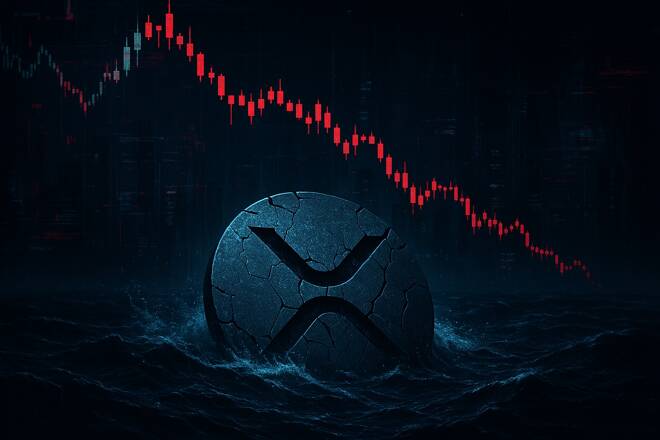Advertisement
Advertisement
XRP News Today: XRP Dips, but ETF Momentum and Legal Progress Offer Hope; BTC at $94k
By:
Key Points:
- SEC delays XRP ETF decision amid Ripple appeal pause; Polymarket gives 77% chance of 2025 approval.
- BTC fell below $95K as US-China trade tensions reignited, weighing on broader market risk sentiment.
- US BTC-spot ETFs saw $1.8B in inflows last week, offering support despite political resistance to the Bitcoin Act.
Banks Turn Bullish on XRP-Spot ETFs
XRP returned to the spotlight on Sunday, May 4, amid rising hopes for approval of an XRP-spot ETF. Crypto enthusiast Amelie, also known as Crypto Barbie, highlighted Standard Chartered Bank’s latest prediction:
“Standard Chartered Bank projects that a US-listed XRP spot ETF could attract between $4.4 billion and $8.3 billion in inflows within its first year.”
For comparison, US ETH-spot ETFs have seen $2.526 billion in net inflows since launch, partly offset by $4.3 billion in outflows from the Grayscale Ethereum Trust (ETHE).
Interest in XRP-spot ETFs intensified after the SEC extended its review of Franklin Templeton’s XRP-spot ETF filing by 45 days.
If approved, strong demand for XRP-spot ETFs could shift the supply-demand balance firmly in XRP’s favor, potentially setting the stage for record highs. Prediction platform Polymarket places the odds of a US XRP-spot ETF approval by December 31 at 77%.
However, the SEC could delay approvals until the conclusion of the SEC vs. Ripple case. In April 2025, the SEC and Ripple filed a joint motion to pause the appeal, citing the prospect of a settlement.
The appeal targets Judge Analisa Torres’ ruling that XRP programmatic sales did not meet the third prong of the Howey Test—a finding that, if upheld, would support the case for SEC approval of pending XRP-spot ETF.
XRP Outlook: Legal Proceedings and ETF Prospects in Focus
XRP dropped 1.32% on Sunday, May 4, following Saturday’s 0.97% loss, closing at $2.1594. The token tracked the broader crypto market, which fell 1.55% to a total crypto market cap of $2.89 trillion. Investors turned cautious as markets braced for the upcoming Fed interest rate decision. Recent US labor market data fueled uncertainty about an H1 2025 Fed rate cut, impacting the crypto market.
XRP price trends will likely depend on:
- Legal progress.
- Updates on ETF filings.
- Fed policy direction and US-China trade developments.
Technical support lies at $2.10, with a break above $2.50 potentially opening a path to $3.00 and a retest of the all-time high at $3.5505.
See our full XRP forecast here.
Bitcoin Drops Below $95,000 as US-China Trade Tensions Resurface
XRP’s losses coincided with bitcoin (BTC) pulling back from the May 2 high of $97,997. Uncertainty surrounding US-China trade talks weighed on risk sentiment, leaving BTC below the crucial $95,000 mark for the first time in four sessions.
Reports of President Trump dismissing plans to speak with China’s President Xi Jinping sank hopes for an end to the US-China trade war. Trump reportedly stated:
“China is ‘ripping us off’ and Chinese and US officials are talking about ‘different things’.”
Risk-off sentiment spilled into broader markets. On May 5, US Futures opened in negative territory, with the Nasdaq 100 down 143 points, while gold rose 0.81% to $3,266 in early trade.
Despite trade uncertainties, BTC’s losses were relatively modest. US BTC-spot ETF net inflows from the week ending May 2 bolstered BTC price support. According to Farside Investors, the US BTC-spot ETF market logged total net inflows of $1,805.1 million.
BTC Price Outlook: Policy and Legislation in Focus
BTC fell 1.67% on May 4, adding to Saturday’s 0.98% loss to close at $94,387.
Near-term price action will likely reflect developments in US-China trade relations, Fed guidance, and ETF flow trends.
Key drivers for BTC’s near-term direction include:
- Bearish Scenario: Rising US-China trade tensions, a hawkish Fed stance, US recession concerns, resistance to the Bitcoin Act, and renewed ETF outflows. Bearish sentiment could send BTC below $90,000.
- Bullish Scenario: De-escalation in the US-China trade war, a dovish Fed outlook, strong US data, pro-crypto legislation, and sustained ETF inflows. Bullish sentiment could drive BTC above $100,000.
Legislative developments may play a pivotal role. The Bitcoin Act’s progress on Capitol Hill could be crucial for BTC’s supply-demand outlook. Senator Cynthia Lummis reintroduced the Bitcoin Act, proposing the US acquire one million BTC over five years with a 20-year holding period, potentially a major demand catalyst.
However, Governor Katie Hobbs of Arizona recently vetoed the state’s Bitcoin reserve bill, raising doubts over bipartisan backing for national crypto strategies.
What to Watch
Market participants should monitor Ripple case-related news, ETF flow dynamics, and macroeconomic indicators, including central bank signals. A favorable outcome for Ripple could lift XRP. Meanwhile, the broader crypto outlook remains tied to regulatory clarity and global risk sentiment.
Read analysts’ insights on what could drive cryptocurrencies to new highs.
About the Author
Bob Masonauthor
With over 28 years of experience in the financial industry, Bob has worked with various global rating agencies and multinational banks. Currently he is covering currencies, commodities, alternative asset classes and global equities, focusing mostly on European and Asian markets.
Advertisement
